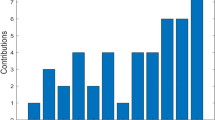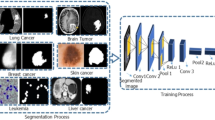Abstract
Most of the developed countries are facing the threat of rapid growth in cases of cancer patients. Cancer is one of the diseases that lead to a high number of deaths every year. Cancer treatment efficacy in medical practice majorly depends upon prediction of cancer susceptibility, cancer prognosis, and cancer recurrence. In recent years, statistical approach of machine learning techniques is proven to be a boon for diagnosis, classification, prediction, and prognosis purposes in health care. Various researchers are implementing machine learning concepts to improve cancer prediction and prognosis. Decision trees, KNN, SVM, and Neural networks are applied to predict the survivability of cancer patients with high accuracy. Recently, researchers are more focused on Deep Learning for better results. However, features for cancer prognosis vary with the type, site, and stage of cancer. For oncological statistical studies, histopathological, biomarker, and genes expression profile data are analyzed, and relationships are inferred for cancer prediction and prognosis. A majority of the studies have been carried out in breast, prostate, and lung cancer as these are most prevailing cancer types. With the emerging technological hazards, environmental factors, and ill habits of people, other types of cancer are also becoming more and more common. The present study provides a review of various features for cancer prognosis and accuracy in prediction of cancer prognosis using different machine learning techniques.
Access this chapter
Tax calculation will be finalised at checkout
Purchases are for personal use only
Similar content being viewed by others
References
Kourou, K., Exarchos, T. P., Exarchos, K. P., Karamouzis, M. V., Fotiadis, D. I., & Kourou, K. (2015) Machine learning applications in cancer prognosis and prediction. Computational and Biotechnology Journal, 13, 8–17.
Cruz, J. A., & Wishart, D. S. (2006). Applications of machine learning in cancer prediction and prognosis. Cancer Informatics, 2, 59–78.
Madabhushi, A., & Lee, G. (2016). Image analysis and machine learning in digital pathology: Challenges and opportunities 1361–8415. Elsevier B.V. http://dx.doi.org/10.1016/j.media.2016.06.037.
Komura, D., & Ishikawa, S. (2018). Machine learning methods for histopathological image analysis. Computational and Structural Biotechnology Journal, 16, 34–42.
Tang, Y., Zhang, Y., Huang, Z., Hu, X., & Zhao, Y. (2008). Recursive fuzzy granulation for gene subsets extraction and cancer classification. IEEE Transactions on Information Technology in Biomedicine, 12(6), 723–730. https://doi.org/10.1109/titb.2008.920787.
Rajeswari, P., & Sophia Reena, G. (2011). Human liver cancer classification using microarray gene expression data. International Journal of Computer Applications, 34(6). ISSN 0975-8887.
Swathi, S., Babu, G. A., Sendhil Kumar, R., & Bhukya, S. N. (2012). Performance of ART1 network in the detection of breast cancer. In 2012 2nd International Conference on Computer Design and Engineering (ICCDE 2012). https://doi.org/10.7763/ipcsit.2012.v49.19.
Sahu, B., & Mishra, D. (2012). A novel feature selection algorithm using particle swarm optimization for cancer microarray data. In International Conference on Modeling Optimization and Computing (ICMOC-2012). https://doi.org/10.1016/j.proeng.2012.06.005.
Dev, J., Dash, S. K., Das, S., & Swain, M. (2012). A classification technique for microarray gene expression data using PSO-FLANN. International Journal on Computer Science and Engineering, 4(9). ISSN:0975-3397.
Bellman, R. E. (1961). Adaptive control processes. Princeton. NJ: Princeton University Press.
Agrawal, S., & Agrawal, J. (2015). Neural network techniques for cancer prediction: A survey. In 19th International Conference on Knowledge Based and Intelligent Information and Engineering Systems. https://doi.org/10.1016/j.procs.2015.08.234.
Khosravi, P., Kazemi, E., Imielinski, M., Elemento, O., & Hajirasouliha, I. (2018). Deep convolutional neural networks enable discrimination of heterogeneous digital pathology images. EBioMedicine, 27, 317–328.
Ford, W., & Land, W. (2014). A latent space support vector machine (LSSVM) model for cancer prognosis. In Conference Organized by Missouri University of Science and Technology 2014, Philadelphia, PA. https://doi.org/10.1016/j.procs.2014.09.023.
Kim, M., Oh, I., & Ahn, J. (2018). An improved method for prediction of cancer prognosis by network learning. Genes, 9, 478. https://doi.org/10.3390/genes9100478.
Carvalho, D., Pinheiro, P. R., & Pinheiro, M. C. D. (2016). A hybrid model to support the early diagnosis of breast cancer. In Information Technology and Quantitative Management (ITQM 2016) (Vol. 91, pp. 927–934).
Asrian, H., Mousannif, H., Moatassime, H. A., & Noeld, T. (2016). Using machine learning algorithms for breast cancer risk prediction and diagnosis. In The 6th International Symposium on Frontiers in Ambient and Mobile Systems (FAMS 2016). Procedia Computer Science, 83, 1064–1069.
Kumari, M., & Singh, V. (2018). Breast cancer prediction system. In International Conference on Computational Intelligence and Data Science (ICCIDS 2018). https://doi.org/10.1016/j.procs.2018.05.197.
Pradeep, K. R., & Naveen, N. C. (2018). Lung cancer survivability prediction based on performance using classification techniques of support vector machines, C4.5 and Naive Bayes algorithms for healthcare analytics. In International Conference on Computational Intelligence and Data Science (ICCIDS 2018) (Vol. 132, pp. 412–420).
Álvarez Menéndez, L., de Cos Juez, F. J., Sánchez Lasheras, F., & ÁlvarezRiesgo, J. A. (2010). Artificial neural networks applied to cancer detection in a breast screening programme. Mathematical and Computer Modelling, 52(2010), 983–991.
Author information
Authors and Affiliations
Corresponding author
Editor information
Editors and Affiliations
Rights and permissions
Copyright information
© 2021 Springer Nature Singapore Pte Ltd.
About this paper
Cite this paper
Deepti, Ray, S. (2021). A Survey on Application of Machine Learning Algorithms in Cancer Prediction and Prognosis. In: Sharma, N., Chakrabarti, A., Balas, V., Martinovic, J. (eds) Data Management, Analytics and Innovation. Advances in Intelligent Systems and Computing, vol 1174. Springer, Singapore. https://doi.org/10.1007/978-981-15-5616-6_25
Download citation
DOI: https://doi.org/10.1007/978-981-15-5616-6_25
Published:
Publisher Name: Springer, Singapore
Print ISBN: 978-981-15-5615-9
Online ISBN: 978-981-15-5616-6
eBook Packages: Intelligent Technologies and RoboticsIntelligent Technologies and Robotics (R0)




